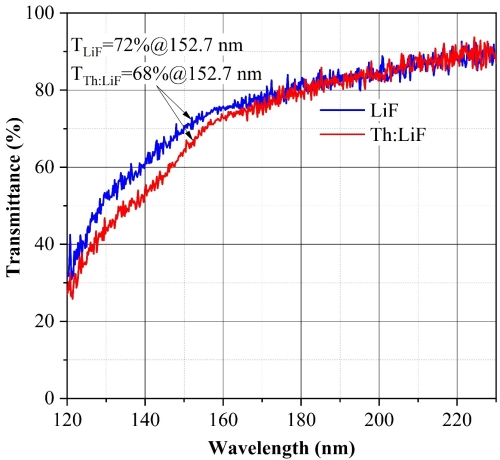The transition energy of nuclide 229Th from its isomeric state 229mTh to its nuclear ground state 229gTh is only about 8 eV, located in the vacuum ultraviolet band. The nuclear optical clock based on the nuclear transition frequency is considered to be a potential new generation of time-frequency standard. Its accuracy may catch up with or even surpass the currently most accurate atomic optical clock.
The solid-state nuclear optical clock based on 229Th doped vacuum ultraviolet (VUV) transparent crystal can obtain high number of Th nuclei that can be interrogated simultaneously and does not need laser cooling. Thereby, it has great advantages in frequency stability (proportional to the square root of the interrogated number of Th nuclei), the excitation and detection of nuclear transition, and the miniaturization, commercialization and spaceborne of nuclear optical clock.
To search for host materials that can meet high doping concentration of thorium, high transmittance and low background luminescence is of great significance for enhancing nuclear transition signal. It is beneficial to the excitation and detection of nuclear transition and the research and development of solid state nuclear optical clock.
The researchers from the Research Center of Laser Crystal at the Shanghai Institute of Optics and Fine Mechanics (SIOM) of the Chinese Academy of Sciences (CAS) have recently made progress in the study of new solid state nuclear optical clock materials. According to the researchers, Th:LiF single crystal is expected to be a promising candidate for solid state nuclear optical clock materials. The related research results have been published on Advanced Optical Materials on February 9, 2023.
The researchers reported the feasibility and potential of thorium-doped lithium fluoride single crystal as a solid-state nuclear optical clock material. The researchers performed systematic theoretical research on Th-doped LiF crystal based on density functional theory (DFT) calculation. The theoretical results demonstrate that thorium nuclei can be effectively doped into the LiF crystal via energetically favorable charge compensation mechanisms in suitable environment. Moreover, the doping of Th will only cause a slight decrease in the VUV transmittance at nuclear transition band of LiF crystal.
Accordingly, Th:LiF crystal was successfully grown experimentally for the first time. The doping concentration of Th in the as-grown crystal can reach about 8.3×1018 cm-3. The transmittance of a 1 mm thick Th:LiF crystal sample can reach T ≈ 68%@152.7 nm, which is slightly lower than that of the same size pure LiF crystal grown under similar conditions.
The theoretical and experimental results both support that the Th:LiF crystal with high doping concentration, high transmittance, and low background luminescence might become a potential promising candidate for solid-state nuclear optical clock materials. It provides new option for the research and development of solid state nuclear optical clocks in the future.

Figure 1. Theoretical models of Th:LiF single crystals. (Image by SIOM)

Figure 2. Electronic Properties of LiF and Th:LiF single Crystals. (Image by SIOM)

Figure 3. VUV transmittance curves of Th:LiF and pure LiF single crystals. (Image by SIOM)
Article website:
https://doi.org/10.1002/adom.202202327
Contact:
WU Xiufeng
General Administrative Office
Shanghai Institute of Optics and Fine Mechanics, CAS
Email: xfwu@siom.ac.cn
Web: http://english.siom.cas.cn/